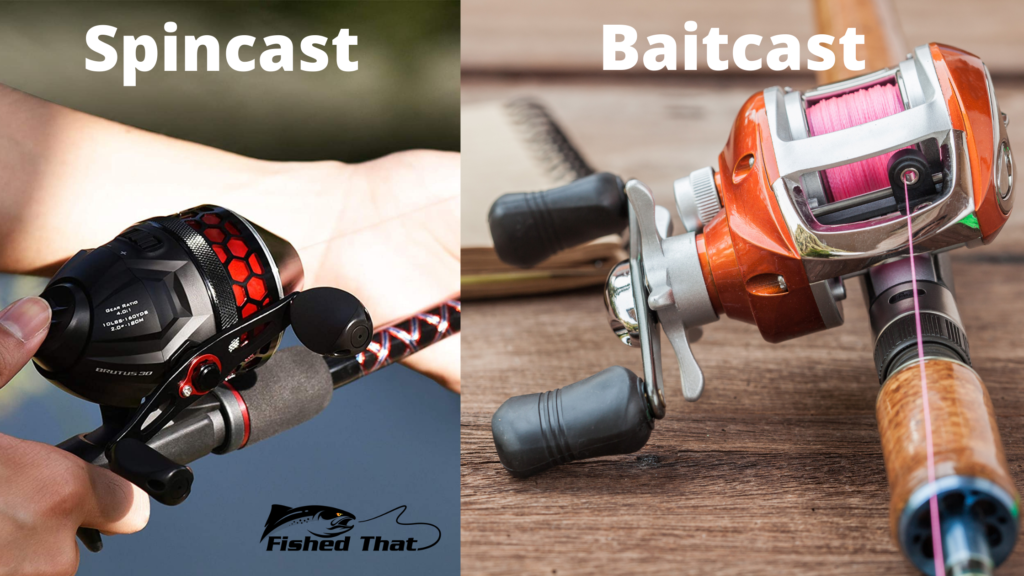At first glance, fishing reels may all look the same. However, there are three different types of fishing reels, and each one has its pros and cons and spooling method. As a matter of fact, there is one particular type of fishing reel best suited for beginner anglers!
1. Spinning Reels

Most anglers use a spinning reel because it offers a large line capacity and is available in different sizes and weights. Plus, you can use either braided or monofilament fishing line. They are particularly favored by beginners.
The spinning reel’s design has a drag adjustment on the top, with a metal bail that acts as a stopper to prevent unspooling. Another importance of the bail is to guide the fishing line evenly back to the spool. The spinning reels attach to the rod from below, and this makes them unique and, at the same time, gives it a perfect balance. The materials used to make the spinning reels are primarily stainless steel, aluminum, or composite materials.
If you’re considering getting a spinning fishing reel, you’ll come across two types – open face and closed face.
The main key difference (aside from the obvious reason that one has an exposed line and the other does not) is the casting. If you are a beginner, a closed-face spinning reel is the best option because it does the work for you. On the other hand, you’ll need to practice more when casting open face spinning reels.
| Pros | Cons |
| Huge selection of models with varying price points | Casting can take patience, especially for open face variants |
| Can accommodate both braided and monofilament | When not well handled, you get twists and tangles |
| Works well with smaller baits and lure | Performance drops when you mount heavier attachments |
| Incredible pulling power | |
How to Cast a Spinning Reel
- Disengage the bail
- Squeeze the line against the rod using your index finger
- Swing the rod overhead or from the side; when doing this, release your index finger halfway during the swing.
- Ensure that you Aim the tip of the rod where you want it to drop
- You must note that you put the bail back to its starting position after the first spin to stop it from tangling
How to Spool a Spinning Reel
The last thing you’d want is to invest in the best spinning reel only to find out that you don’t know how to spool it. Here’s how:
- Select the perfect line that will work well with your line while considering what type of water you will be fishing in.
- Check if your reel rotates clockwise or counterclockwise: to know this hold the reel like you are fishing and turn the wheel three times to check its direction.
- Flip the small handle up to open the bail.
- Use the guides to string your reel.
2. Baitcasting Reels

Pro anglers use baitcasting reels because it is more powerful and precise than other types of fishing reels. And, as you might have guessed, baitcasting reels have more moving parts that require more effort to learn and use.
A baitcasting reel sits on the top of the rod handle and usually has a sturdier build when it features a semi-enclosed design. You’ll also notice that it has a drag mechanism next to the reel handle. Other components that make this fishing reel efficient and reliable are its braking system and spool tension.
The above mechanisms help adjust how fast the spool gets out of the reel.
| Pros | Cons |
| Most powerful option out of the three types of fishing reels. | Different spool and brake settings required for different lures |
| Highly customizable for different fishing situations and needs | Takes more time to master versus other reel types |
| Can accommodate fluro, braided, mono, and nylon fishing lines | High price tag. The average cost is between $100 to $500 for a quality baitcasting reel. |
| Offers impressive control and balance |
How to Cast a Baitcasting Reel
- Place your thumb on the button.
- Position the line and rod in front of you. Keep it straight.
- Lift your fishing rod slightly over your shoulder. Maintain thumb pressure as much as possible.
- In one swift motion, move your wrist forward and release your thumb on the button. Reposition your thumb above the line.
- Use your thumb to stop the line. Only do this step when the line has slowed down. Pro Tip: You should stop the line before the lure hits the water.
- Lock the spool and disengage the reel’s release.
How to Spool a Baitcasting Reel
A baitcasting reel might be powerful, but it’s useless if you’ve incorrectly spooled it. Here’s the correct way to spool it:
- Pass the line through the rod guides, and the reels level wind guide.
- Wrap your line around the spool, then tie an over knot on the line.
- Complete the knot by tying an arbor knot on the line’s tag, then pull till the line is tight.
- Trim the end of the tag before reeling in the line.
- Run the line between your thumb and forefinger to keep tension on the line.
3. Spincast Reels

A spincast reel is the most user-friendly out of the three types of fishing reels. However, there are some drawbacks compared to either a baitcasting reel or a spinning reel. One of which is a limited range of cast.
How does a spincast reel work, you ask? This type of fishing reel has a metallic nose cone that covers all the reel’s internal components. Behind the cone, you’ll find a button designed to help shift the reel from the locking position to the free spool. It also has a drag adjustment mechanism that helps regulate the amount of resistance that a fish feels when pulling on your line.
| Pros | Cons |
| Most affordable type of fishing reel | Cheaper build or construction |
| Great for beginners – adults or kids | Drag system is not made for larger fish like salmon |
| Hassle-free maintenance | Maximum line capacity is limiting |
| Can be used with one hand | Repairs can be challenging; a replacement is more suitable |
How to Cast a Spincast Reel
All you need to do is press the spool control button, and then you take a swing and release. When you press the release button, the line will fly to where the tip of the rod is pointing. To stop the line, you need to press the button again.
How to Spool a Spincast Reel
- Remove the cover.
- Run the line through the hole in the cover, tie it up on the reel’s spool, and make an arbor knot.
- Return the cover and ensure that it is tight.
- Lay the filler spool on the floor and reel in the new line
Baitcast vs Spincast vs Spinning
What Is the Difference Between Spincast vs Baitcast Reels?
The main difference between a spincast reel and baitcast reel is the placement of the fishing line spool. On spincasting reels, the spool is perpendicular to the fishing rod whereas on the baitcasting reel the spool is parallel to the fishing rod. Baitcaster reels are mainly used by experienced anglers since the spool moves with the casting of the line that may result in knots if the spool ends up moving faster than your casting line.

What’s the Difference Between a Spincast and Spinning Reel?
The techniques for spincast and spinning reels are similar. The main difference between the two reels is that spinning reels have an open face and a metal bail to prevent the line from nesting. For beginner fishermen, these fishing rods will look familiar. On the other hand, spincast reels have a closed face and usually have a button that’s used to lock and unlock the spool. Both reels are popular with beginners, but these days spinning reels tend to be favored since they are user-friendly, resilient as well as versatile in nature. Spinning reels also have a longer casting range.

Final Thoughts
Fishing is one of the best activities you can engage in as a hobby or a sport. However, it is essential to ensure that you have the best fishing reel suited for your skill level and fishing needs.
Table of Contents



